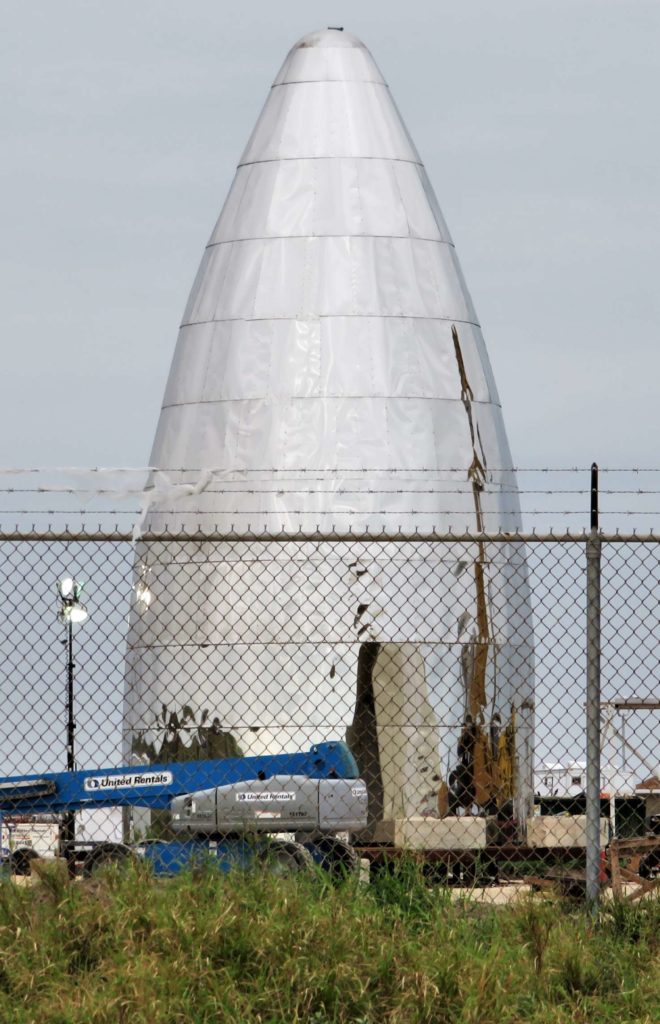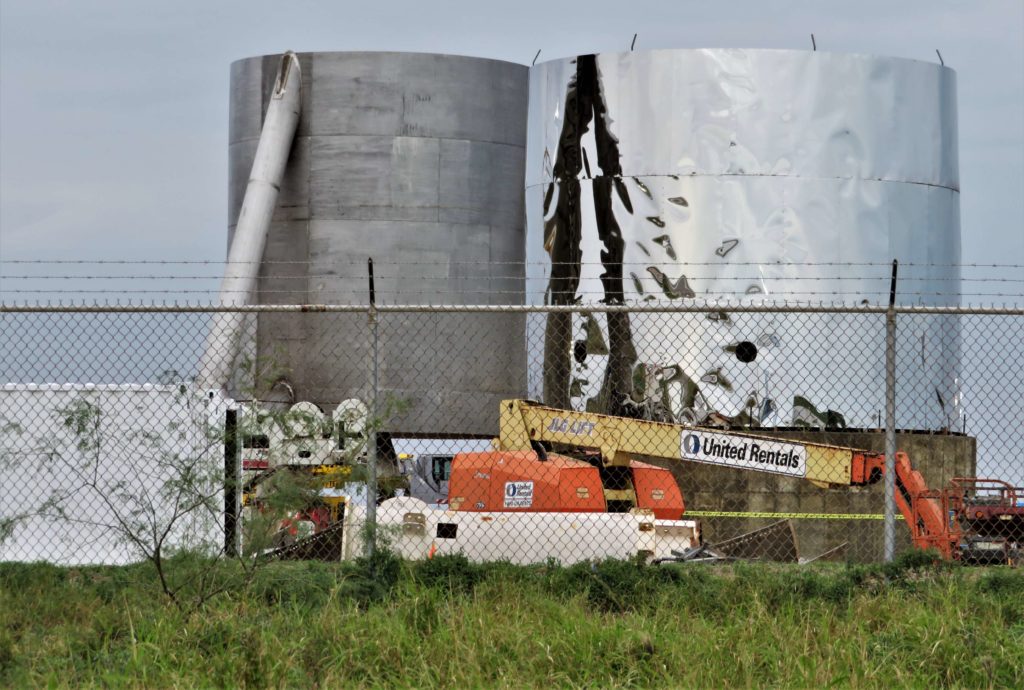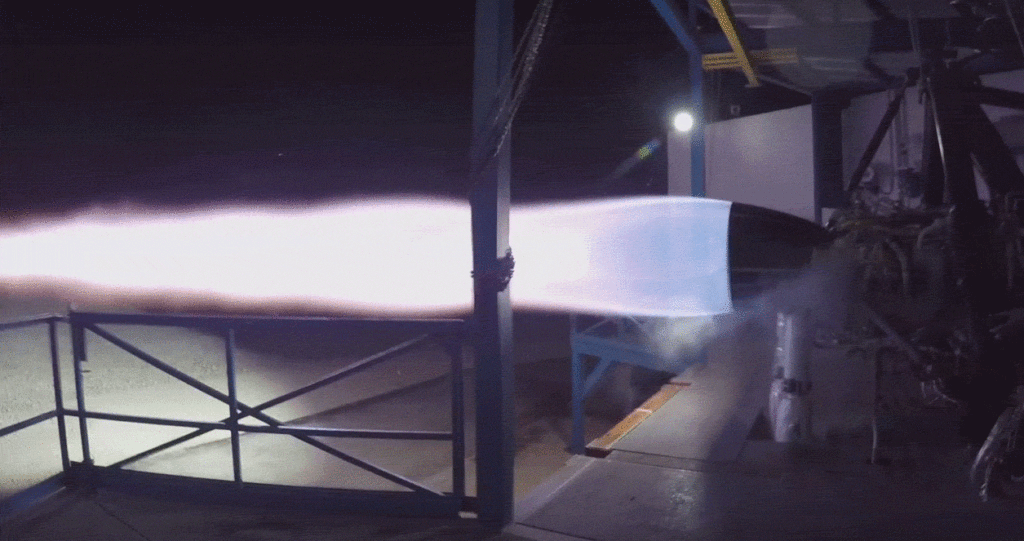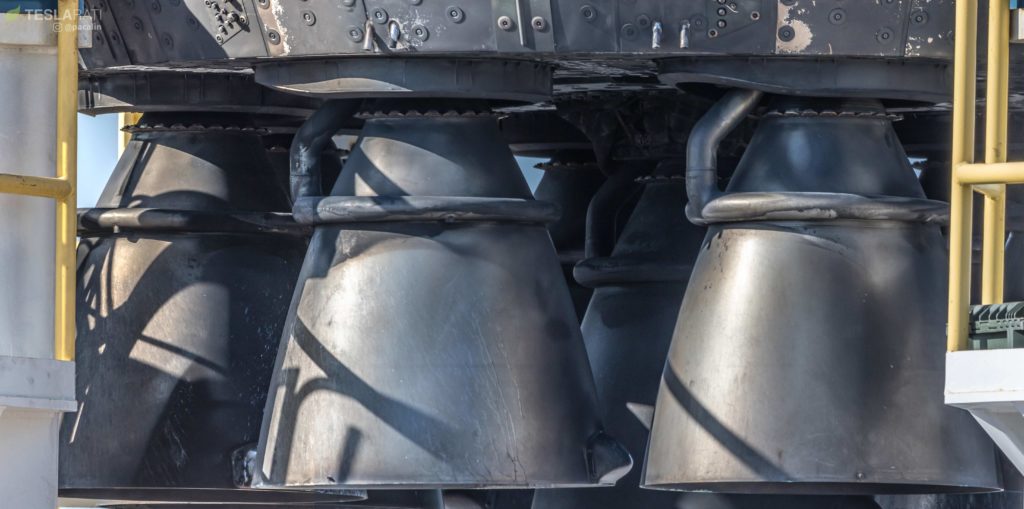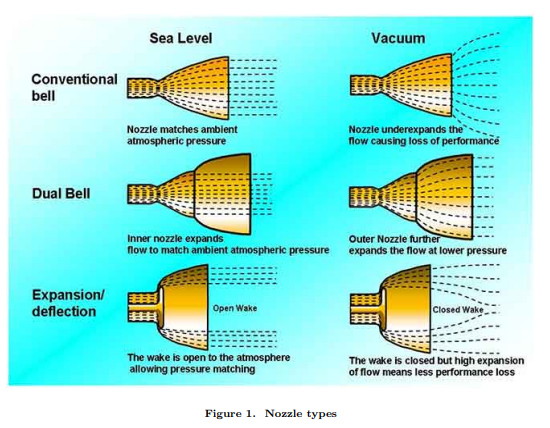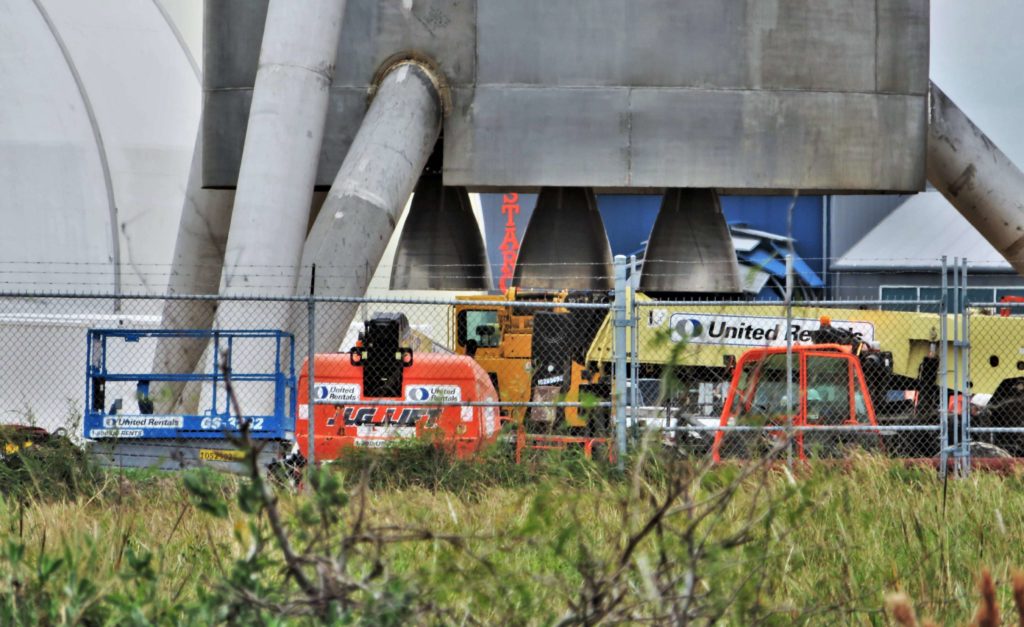
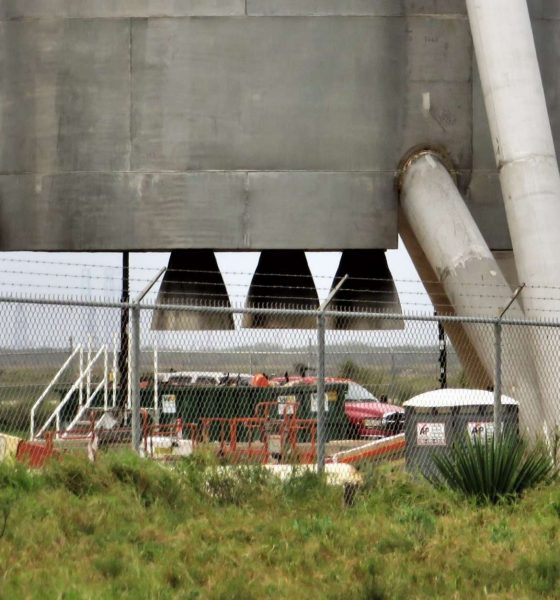
SpaceX
SpaceX’s Starship hopper spotted with trio of dual-bell Raptor engines
Following a brief ‘hop’ (via crane) off of a concrete build stand, the aft section of SpaceX’s first full-scale Starship hopper (Starhopper?) revealed that SpaceX technicians have already installed what appear to be three real Raptor engines, presumably the first time the propulsion system has ever been mounted to something that might eventually fly.
For a number of reasons, there is a strong chance that these Raptors are actually just boilerplate placeholders standing in as structural guides for the real deal some months down the line. On the other hand, there are also a number of reasons to assume that these apparent engines are indeed real Raptors.
Star ship hopper might be a bit bigger than we thought and with the crane placements over the nose end of the vehicle. This could suggest, @SpaceX are planning to move the segment elsewhere perhaps to the welding stand? We will have to wait and see. (Austin Barnard📸) #2019🚀 pic.twitter.com/kn8hhUPWCU
— Austin Barnard🚀 (@austinbarnard45) January 1, 2019
Despite an already shocking series of rapid-fire developments in the South Texas Starhopper saga, the abrupt appearance of what appears to be three Raptor engines – mirroring CEO Elon Musk’s recent statement that the test vehicle would sport three Raptors – is by far the most unexpected moment yet for the prototype Starship. Purportedly a full-scale prototype of BFR’s upper stage/spaceship (now known as Starship), Musk indicated over the last two weeks that the hopper has been designed to perform a number of hop tests in which the craft’s three Raptors would power it to a range of (relatively low) altitudes above Boca Chica, Texas.
According to a recent FCC filing related to this test program, SpaceX is currently seeking a license for Starship hop tests that will not exceed 5 km (3.1 mi) in altitude and/or 6 minutes in duration. There is admittedly nothing mentioned about the maximum allowed velocity during those tests, but – much like Blue Origin performs supersonic tests of New Shepard in Cape Horn, Texas – SpaceX will likely seek and be granted permission to break the sound barrier during those hypothetical tests. Nevertheless, a 5km ceiling is a fairly significant cap on the range of performance Starhopper will be able to test – accelerating vertically at 2Gs, Starhopper could travel from sea level to 5km in less than 30 seconds while reaching speeds no higher than Mach 1-1.5.
- SpaceX technicians and engineers are continuing to work at a breakneck pace on Starhopper. (NASASpaceflight – bocachicagal)
- At this rate, the hopper will likely wind up around 40m (130 feet) tall. (NASASpaceflight – bocachicagal)
- A close examination of these three engine-like protrusions suggests a level of fit and finish far exceeding a boilerplate stand-in. (NASASpaceflight – bocachicagal)
Combined with the apparent fact that this Starhopper’s fins seem unlikely to ever actuate (i.e. no aerodynamic control surfaces), it’s probable that this ad hoc prototype is only meant to perform a very limited range of hop tests, perhaps as basic as ironing out the kinks of operating a trio of gimballed Raptors and ensuring that they can safely and reliably launch, hover, and land a very large Starship-shaped mass simulator. Falcon 9’s Grasshopper and F9R reusability testbeds performed a very similar task some five years ago, offering SpaceX engineers the opportunity to optimize software and hardware needed to reliably recover real orbital-class rockets after launch. Although Falcon 9 has nine gimballed Merlin 1D engines, SpaceX has long sided with the sole center Merlin as the dedicated landing engine and has only briefly experimented with triple-Merlin landing burns.
Dual-expansion whaaaaat?
According to Musk, Raptor – an advanced liquid methane and oxygen engine with a uniquely efficient propulsion cycle – was expected to produce an impressive ~2000 kN (200 ton, 450K lbf) of thrust in its finished form as of September 2018. However, Musk also mentioned in a late-2017 Reddit AMA that SpaceX engineers were modifying the ship’s design to ensure engine-out reliability during all regimes of flight, landing in particular. To accomplish this feat with an engine as powerful as Raptor, two or three Raptors – capable of producing as much as 600 tons of thrust total – would need to reliably throttle as low as 25%, assuming a landing mass of around 150t. To allow a nearly empty ship (~100t) to still reliably land with three Raptors ignited, the engines would need to be able to throttle to 20% or less.

Known as deep throttling in rocketry, ensuring stable combustion and thrust at 20% (let alone 40%) throttle is an extraordinarily challenging feat, often subjecting engines to forces that can literally tear non-optimized hardware apart. To achieve such a deep throttle capability without excessively disrupting the engine’s design, SpaceX appears to have potentially sided with less efficient but extremely simple alternative, known as a dual-bell (or dual-expansion) rocket nozzle. A 1999 Rocketdyne paper concisely explained the primary draws of such a nozzle:
“The [altitude-compensating] dual-bell nozzle offers a unique combination of performance, simplicity, low weight, and ease of cooling” – Horn & Fisher, 1999
Exactly
— Elon Musk (@elonmusk) December 27, 2018
Given that SpaceX has decided to delay the introduction and certification of a vacuum-optimized Raptor engine, choosing to instead use the same Raptor on both BFR stages, something like a dual-bell nozzle would be one of the best possible ways for the company to retain some of the efficiency benefits of a vacuum engine while also drastically improving design simplicity, ease of manufacturing, and cutting development time. Aside from offering efficiency gains by way of altitude compensation, a dual-bell nozzle also happens to enable a given engine to operate a much wider throttle range by mitigating problems with flow separation and instability.
- A gif of Raptor throttling over the course of a 90+ second static-fire test in McGregor, Texas. (SpaceX)
- Note that Merlin 1D and prior Raptor prototypes both feature traditional single nozzles. (Pauline Acalin)
- An overview of dual-bell and deflection nozzles. Raptor appears to have now graduated to the former style. (Johan Steelant, 2011)
- Starhopper’s Raptors feature a very distinct seam and second curve, indicative of a dual-bell nozzle. (NASASpaceflight /u/bocachicagal)
For Starhopper and Starship, both aspects are an undeniable net-gain and it’s entirely possible that these dual-bell nozzles – if successfully demonstrated – could find their way onto Falcon 9 and Falcon Heavy to further boost their booster performance and efficiency.
For prompt updates, on-the-ground perspectives, and unique glimpses of SpaceX’s rocket recovery fleet check out our brand new LaunchPad and LandingZone newsletters!

News
SpaceX shades airline for seeking contract with Amazon’s Starlink rival

SpaceX employees, including its CEO Elon Musk, shaded American Airlines on social media this past weekend due to the company’s reported talks with Amazon’s Starlink rival, Leo.
Starlink has been adopted by several airlines, including United Airlines, Qatar Airways, Hawaiian Airlines, WestJet, Air France, airBaltic, and others. It has gained notoriety as an extremely solid, dependable, and reliable option for airline travel, as traditional options frequently cause users to lose connection to the internet.
Many airlines have made the switch, while others continue to mull the options available to them. American Airlines is one of them.
A report from Bloomberg indicates the airline is thinking of going with a Starlink rival owned by Amazon, called Leo. It was previously referred to as Project Kuiper.
American CEO Robert Isom said (via Bloomberg):
“While there’s Starlink, there are other low-Earth-orbit satellite opportunities that we can look at. We’re making sure that American is going to have what our customers need.”
Isom also said American has been in touch with Amazon about installing Leo on its aircraft, but he would not reveal the status of any discussions with the company.
The report caught the attention of Michael Nicolls, the Vice President of Starlink Engineering at SpaceX, who said:
“Only fly on airlines with good connectivity… and only one source of good connectivity at the moment…”
CEO Elon Musk replied to Nicolls by stating that American Airlines risks losing “a lot of customers if their connectivity solution fails.”
American Airlines will lose a lot of customers if their connectivity solution fails
— Elon Musk (@elonmusk) December 14, 2025
There are over 8,000 Starlink satellites in orbit currently, offering internet coverage in over 150 countries and territories globally. SpaceX expands its array of satellites nearly every week with launches from California and Florida, aiming to offer internet access to everyone across the globe.
Currently, the company is focusing on expanding into new markets, such as Africa and Asia.
News
Tesla hints at Starlink integration with recent patent
“By employing polymer blends, some examples enable RF transmission from all the modules to satellites and other communication devices both inside and outside the vehicle.”

Tesla hinted at a potential Starlink internet terminal integration within its vehicles in a recent patent, which describes a vehicle roof assembly with integrated radio frequency (RF) transparency.
The patent, which is Pub. No U.S. 2025/0368267 describes a new vehicle roof that is made of RF-transparent polymer materials, allowing and “facilitating clear communication with external devices and satellites.”
Tesla believes that a new vehicle roof design, comprised of different materials than the standard metallic or glass elements used in cars today, would allow the company to integrate modern vehicular technologies, “particularly those requiring radio frequency transmission and reception.
Tesla has recently filed a US patent application on integrating RF transparent materials into the roof structure.
“facilitating clear communication with external devices and satellites”
Tesla fleet is getting @Starlink connectivity integration soon. LFG @Tesla @elonmusk… pic.twitter.com/bLa8YtPLd1
— Chansoo Byeon (@Chansoo) December 9, 2025
Instead of glass or metallic materials, Tesla says vehicles may benefit from high-strength polymer blends, such as Polycarbonate, Acrylonitrile Butadiene Styrene, or Acrylonitrile Styrene Acrylate.
These materials still provide ideal strength metrics for crashworthiness, stiffness for noise, vibration, and harshness control, and are compliant with head impact regulations.
They would also enable better performance with modern technologies, like internet terminals, which need an uninterrupted signal to satellites for maximum reception. Tesla writes in the patent:
“By employing polymer blends, some examples enable RF transmission from all the modules to satellites and other communication devices both inside and outside the vehicle.”

One of the challenges Tesla seems to be aware of with this type of roof design is the fact that it will still have to enable safety and keep that at the forefront of the design. As you can see in the illustration above, Tesla plans to use four layers to increase safety and rigidity, while also combating noise and vibration.
It notes in the patent that disclosed examples still meet the safety requirements outlined in the Federal Motor Vehicle Safety Standards (FMVSS).
Starlink integrated directly into Tesla vehicles would be a considerable advantage for owners. It would come with a handful of distinct advantages.
Initially, the inclusion of Starlink would completely eliminate cellular dead zones, something that is an issue, especially in rural areas. Starlink would provide connectivity in these remote regions and would ensure uninterrupted service during road trips and off-grid adventures.
It could also be a critical addition for Robotaxi, as it is crucial to have solid and reliable connectivity for remote monitoring and fleet management.
Starlink’s growing constellation, thanks to SpaceX’s routine and frequent launch schedule, will provide secure, stable, and reliable internet connectivity for Tesla vehicles.
Although many owners have already mounted Starlink Mini dishes under their glass roofs for a similar experience, it may be integrated directly into Teslas in the coming years, either as an upgrade or a standard feature.
Investor's Corner
SpaceX IPO is coming, CEO Elon Musk confirms
However, it appears Musk is ready for SpaceX to go public, as Ars Technica Senior Space Editor Eric Berger wrote an op-ed that indicated he thought SpaceX would go public soon. Musk replied, basically confirming it.

Elon Musk confirmed through a post on X that a SpaceX initial public offering (IPO) is on the way after hinting at it several times earlier this year.
It also comes one day after Bloomberg reported that SpaceX was aiming for a valuation of $1.5 trillion, adding that it wanted to raise $30 billion.
Musk has been transparent for most of the year that he wanted to try to figure out a way to get Tesla shareholders to invest in SpaceX, giving them access to the stock.
He has also recognized the issues of having a public stock, like litigation exposure, quarterly reporting pressures, and other inconveniences.
However, it appears Musk is ready for SpaceX to go public, as Ars Technica Senior Space Editor Eric Berger wrote an op-ed that indicated he thought SpaceX would go public soon.
Musk replied, basically confirming it:
As usual, Eric is accurate
— Elon Musk (@elonmusk) December 10, 2025
Berger believes the IPO would help support the need for $30 billion or more in capital needed to fund AI integration projects, such as space-based data centers and lunar satellite factories. Musk confirmed recently that SpaceX “will be doing” data centers in orbit.
AI appears to be a “key part” of SpaceX getting to Musk, Berger also wrote. When writing about whether or not Optimus is a viable project and product for the company, he says that none of that matters. Musk thinks it is, and that’s all that matters.
It seems like Musk has certainly mulled something this big for a very long time, and the idea of taking SpaceX public is not just likely; it is necessary for the company to get to Mars.
The details of when SpaceX will finally hit that public status are not known. Many of the reports that came out over the past few days indicate it would happen in 2026, so sooner rather than later.
But there are a lot of things on Musk’s plate early next year, especially with Cybercab production, the potential launch of Unsupervised Full Self-Driving, and the Roadster unveiling, all planned for Q1.
